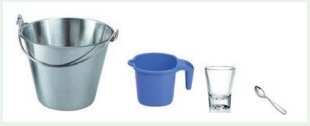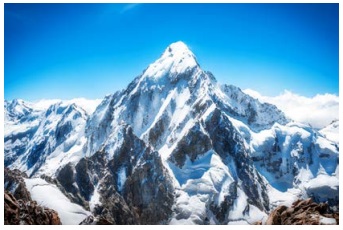Water | Term 3 Unit 2 | 6th Science - Student Activities | 6th Science : Term 3 Unit 2 : Water
Chapter: 6th Science : Term 3 Unit 2 : Water
Student Activities
Activity 1: Relative amount of water at various sources

Take a 20 litre bucket, a 500 ml mug, a 150 ml tumbler and a 1 ml spoon. If the capacity of the bucket is 20 litre, then it represents the total amount of water present on the Earth. Now, transfer a mug of water from the bucket and it is 500 ml and then it represents the total amount of fresh water present in the Earth. The water left in the bucket represents seas and oceans. This water is not fit for human use.
The water present in the mug represents the freshwater which is present in frozen form on snow-covered mountains, glaciers and polar ice caps. This water is also not readily available for human use. Next, transfer 150 ml of water to the tumbler, then it represents the total amount of ground water. Finally, take one-fourth spoonful of water while the capacity of the spoon is 1 ml, then it represents the total amount of surface water (i.e) water seen in all the rivers, lakes and ponds of the world. It can be taken as potable water.
When such a small amount of potable water is available, then we should be more cautious in handling water. Is it not?

Activity 2: Conduct the activity with common salt,sand, chalk powder, charcoal powder and copper sulphate.
Fill up the following table.


From the above activity we could observe that common salt and copper sulphate dissolve in water and contribute their properties like colour and other properties to water but sand, chalk powder and charcoal powder do not dissolve in water.
Activity 3: Water contains dissolved salts
Take some tap water in a china dish and heat it. Continue heating till all the water gets dried up. Stop the heating and look at the china dish. What do you observe inside the china dish?
Deposits of some solid particles on the surface of china dish can be observed. The deposit is of salts that are dissolved in water. This shows that water has dissolved salts in it.

Note: Do not use distilled water or water from purifier or RO unit and the like for this activity.
Activity 4: Spread a piece of we cloth in the sunlight. Observe after some time. Where has the water in the wet cloth gone?

The water evaporates into the atmosphere due to the heat of the sun.
Activity 5: Condensation of water vapour.
Take a glass half filled with water. Wipe the outer surface of the glass with a clean piece of cloth. Add some ice into the water. Wait for one or two minutes. Observe the changes that take place on the outer surface of the glass.
From where do water drops appear on the outer side of the glass?
The cold surface of the glass containing icy water cools the air around it and the water vapour of the air condenses on the surface of the glass. This process is also the result of condensation of water vapour.
The Himalayas
The Himalayas, contain ice caps, ice bergs and glaciers. Ten of Asia’s largest rivers flow from the Himalayas and more than a billion people’s livelihoods depend on those rivers.

More to know: Water, is measured in litre and millilitre. Gallon is also a measure of volume of liquids.
1 Gallon = 3.785 litre
Water level in the reserviors is measured in TMC/feet. Water released from dams is measured in cusec (cubic feet/sec).
Aquatic animals
During winter, water in lakes and ponds in the cold countries will be frozen and a solid layer of ice is formed on the surface of water. Still aquatic animals living under the ice do not die. This is because the floating layer of ice acts as a protective coat, and doesn’t permit heat to escape from water. So as the water at the surface alone turns to ice, it the existence of aquatic animals.
Coovam is an estuary!
Estuaries are wetlands where water bodies meet fresh water from land meeting the salty seawater. Estuaries are home to unique plants and animal species.

Swamps are wetlands that are forested. They occur along large rivers or on the shores of large lakes. The water of a swamp may be freshwater, brackish water or seawater. Swamps are important for providing fresh water and oxygen to all life. Pichavaram Mangroves in Chidambaram, Muthupet mangrove wetland. Pallikkaranai wetland in Chennai, Chembarambakkam in Kancheepuram are a few examples of swamps in Tamilnadu.
Activity 6: Estimation of water consumed by a family on a day

Let us avoid wasting water
When you happen to see any leaking tap in your school or home, keep a bucket to collect the water that is leaking and measure the amount of water and the time taken to fill the bucket. After noting the time taken to fill a bucket, you can estimate the amount of water getting wasted on a day.
Can you please think over the amount of water getting wasted all around the world from the leaking taps?

Related Topics